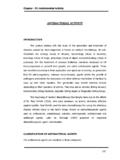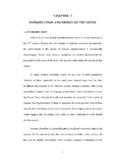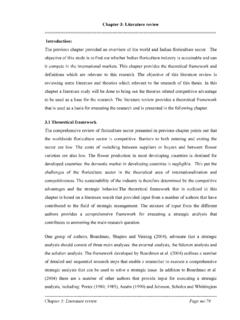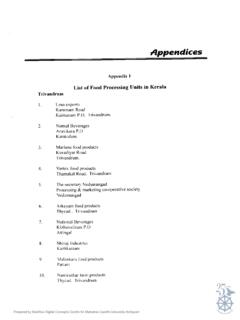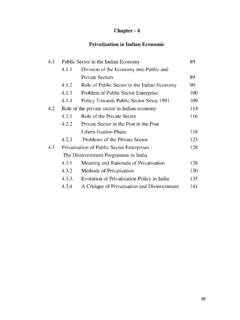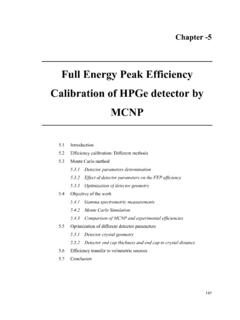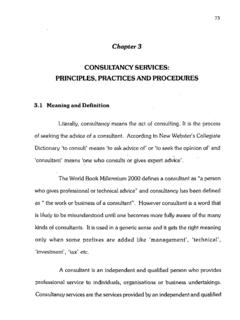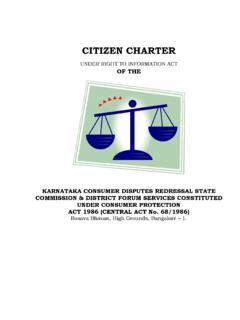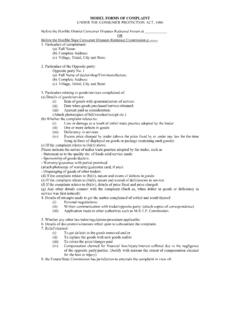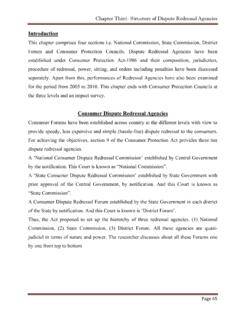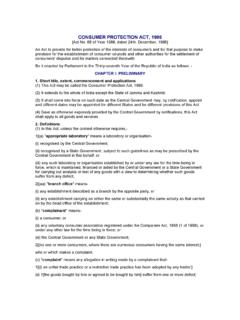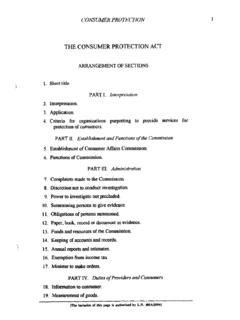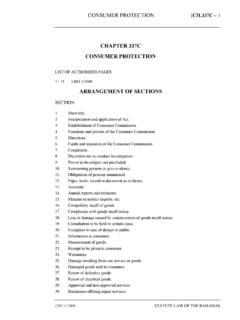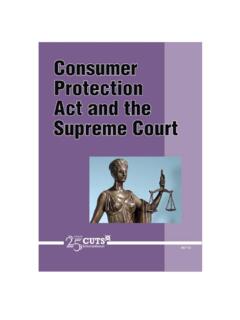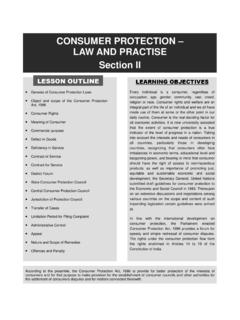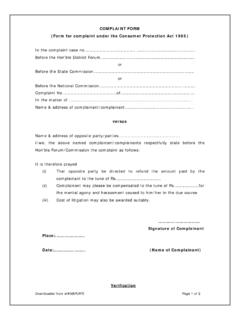Transcription of CHAPTER-III OBJECTIVES AND SCOPE OF THE CONSUMER ...
1 CHAPTER-III OBJECTIVES AND SCOPE OF THE CONSUMER protection ACT, 1986 INTRODUCTION The CONSUMER protection Act, 1986 was enacted to provide for better protection of the interest of the consumers and for the purpose to make provisions for the establishment of CONSUMER Councils and other authorities in the settlement of CONSUMER disputes and for matters connected therewith. It seeks, inter-alia, to promote and to protect the rights of consumers such as protection against marketing of goods which are hazardous to life and property, the right to be informed about the quality, quantity, potency, purity, standard and price of goods to protect the CONSUMER against unfair trade practices, the right to be assured, wherever possible, access to variety of goods at competitive prices, the right to be heard and to be assured that the interest of consumers will receive due consideration at appropriate forums.
2 The right to seek redressal against unfair trade practices or unscrupulous exploitation of consumers and right to CONSUMER education. The object is also to provide speedy and simple redressal to CONSUMER disputes-quasi judicial machinery is sought to be set up at District, State and Central Levels. These quasi-judicial bodies are to observe principles of natural justice and have been empowered to give relief of specific nature and to award, wherever appropriate, compensation to consumers. Penalties for non-compliance of orders given by quasi-judicial bodies have also been provided.
3 69 PREAMBLE OF CONSUMER protection ACT It is not necessary that every act passed by legislature must have the preamble. However, when preamble is added to an Act, it is a part of Act itself. The preamble of CONSUMER protection Act, 1986 reads a follows: An act to provide for better protection of the interest of consumers and for that purpose to make provision for the establishment of CONSUMER councils and other authorities for the settlement of CONSUMER s disputes and for matters connected therewith. From above, it would be seen that the CONSUMER protection Act, 1986 seeks to provide for better protection of the interest of consumers and for that purpose to make provision for establishment of CONSUMER councils and other authorities for the settlement of consumers disputes.
4 SHORT TITLE, EXTENT, COMMENCEMENT AND APPLICATION The title of present Act is the CONSUMER protection Act, 1986 . It clearly reflects that purpose of the Act is to protect the interest of CONSUMER . chapter I, II and IV of the Act came into force 15th April, 1987 and chapter III of the Act came into operation with effect from Ist July, 1987 in the whole India except the state of Jammu and Kashmir since separate legislation has been inacted for the state of Jammu and Kashmir know as the Jammu and Kashmir CONSUMER protection Act, 1987. Save as otherwise expressly provided by the Central Government by notification, the provisions of the CONSUMER protection Act, 1986 as amended from time to time has made applicable to all the goods and services.
5 The Act seeks to protect the consumers in the following respects:- 70 (1) It seeks, inter-alia, to promote and protect the rights of consumers such as The CONSUMER protection a) The right to be protected against marketing of goods and services which are hazardous to life and property; b) The right to be informed about the quality, quantity, potency, purity, standard and price of goods or services, as the case may be, so as to protect the consumers against unfair trade practices; c) The right to be assured, wherever possible, of access to a variety of goods and services at competitive prices; d) The right to be heard and to be assured that consumers interests will receive due consideration at appropriate forums; e) The right to seek redressal against unfair trade practices or restrictive trade practices or unscrupulous exploitation of consumers; and f) The right to CONSUMER education.
6 chapter -II of the CONSUMER protection Act, 1986 provides for establishment of central CONSUMER protection council and state CONSUMER protection council while chapter III of the Act which is in fact is regarded as the soul of the Act, provides for establishment of three tier CONSUMER disputes redressal agencies namely (i) the district form, (ii) the state commission, (iii) the national CONSUMER disputes redressal commission. (2) Section 6 of the Act spells out these objects and charges the Central Council with the responsibilities of fulfilling these objects. The section says that the objects of the Central Council shall be to promote and protect the rights of the consumers which have been listed in Section 6.
7 They are as follows: 71 a) protection Against Hazardous Goods :- The Act says in the first place that the CONSUMER has a right to be protected against the marketing of goods which are hazardous to life and property. b) Right to CONSUMER Information :- The CONSUMER has been given the right to informed by the producer about the quality, quantity, potency, purity, standard and prices of goods he buys. c) Right of Access to Variety of Goods and at Competitive Prices :- The central council as constituted under the Act has been charged with the responsibility of bringing about the organization of markets and market practices in such a way that all dealers are supplied with a variety of goods for the benefit of the CONSUMER and that the goods with a variety are being offered at competitive prices.
8 D) Right to Due Attention at Appropriate Forums :- That Central CONSUMER protection Council has been charged with the responsibility of assuring consumers that they would be heard as of right by the appropriate forums and the CONSUMER will receive due attention and consideration from such Forums. e) Right Against Unscrupulous Exploitation, Restrictive and Unfair Trade Practices :- The CONSUMER has been given the right to seek redress against restrictive or unfair trade practices1 or unscrupulous exploitation. f) Right to CONSUMER Education :- This has been made one of the missions of the CONSUMER protection Act, 1986 and the Central CONSUMER protection Council has been charged with the responsibility to provide to the people proper education in terms of their remedies under the Act.
9 Once the people are 1 National CONSUMER protection Samiti v. Chief Electrical Supervisor, 1991 CPR 191 Guj. 72 rendered conscious of their power, they may, perhaps, feel energized to struggle against exploitation by manufacturers and traders. Controlling hands and tools of the govt. are easily corruptible. They also suffer from slow motion. They often fail in their mission. But consciousness of the people as a whole, for every person is a CONSUMER one way or the other, when aroused by proper CONSUMER education, is likely to be above petty temptations and therefore more effective in its mission.
10 (3) To provide speedy and simple redressal to CONSUMER disputes, a quasi judicial machinery is sought to be set up at district, state and central level. WHO CAN MAKE A COMPLAINT? To initiate an action under the CONSUMER protection Act, 1986, (hereinafter referred to as the Act) what is required is a complaint from the complainant. The term complaint has been defined in section 2(1)(d) of the Act. According to clause (b) of section 2(1) of the CONSUMER protection Act, a complaint can be made by any of the following: (i) a CONSUMER or (ii) any voluntary CONSUMER association registered under the Companies Act, 1956 (1 of 1956), or under any other law for the time being in force; or (iii) the Central Government or any State Government, who or which makes a complaint; or (iv) one or more consumers, where there are numerous consumers having the same interest; (v) In case of death of a CONSUMER , his legal heir or representative.
